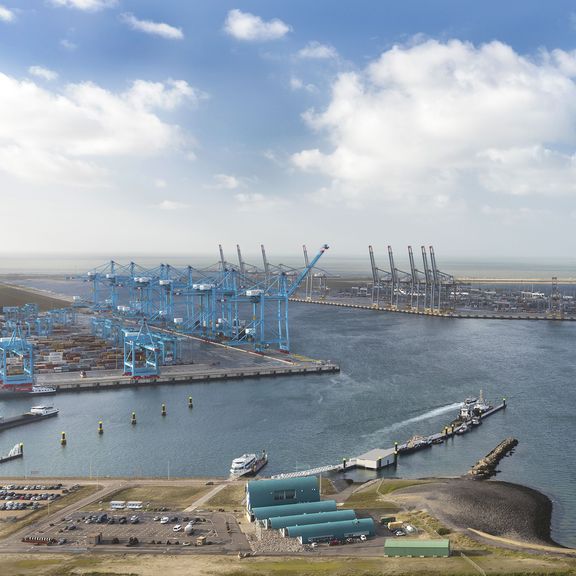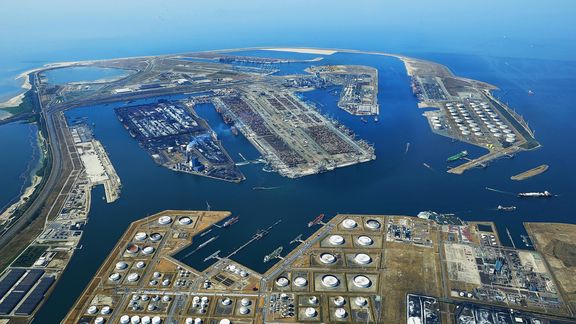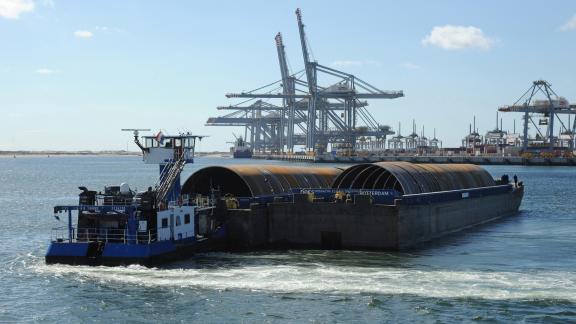
New port area at sea
The two most up-to-date automatic container terminals in the world, the largest sea-going vessels on earth, giant foundation piles for offshore wind turbines, and a permanent berth for the world’s largest vessel, the Pioneering Spirit, and two berths for ship to ship handling; the developments since the completion of construction in 2013 are impressive.
Visit FutureLand
If you’d like to find out more about the construction and layout of this port expansion or other developments in Europe’s largest port, you can visit FutureLand Information Centre. Since the start of the construction of Maasvlakte 2 in 2009, over 100,000 visitors have visited the interactive information centre each year. As well as the information on offer, visitors to the centre also take tours by boat or coach. The year-round programme serves a wide audience: from children to professionals and from international delegations to family excursions or even complete school classes.
Following an extensive and thorough decision-making phase, a start was made with the construction of the new port area at sea in 2009. With a total surface area of 2,000 hectares, Maasvlakte 2 ultimately offers 1,000 hectares of space to innovative, sustainable, deep sea-related port industry. Port basins, seawall and infrastructure such as rail and road already occupy 1,000 hectares. The recent expansion enabled the Port of Rotterdam to grow by 20 per cent.
Construction of a port extension in the sea
Before Maasvlakte 2 emerged, the sea was approximately 17 metres deep. Sand was needed to spray new land to some 5 metres above sea level – a lot of sand. In the first phase up to 2013, trailing suction hopper dredgers extracted the bulk of the sand at carefully-selected sand extraction locations in the North Sea. The remaining sand was released during the realisation of the Yangtzekanaal, the maritime access to the new port area via Maasvlakte. Sand was also extracted during the deepening of the new port basins and during other port area projects. Not only efficient, but also better for the environment. In total, 240 million cubic metres of sand were applied during the first phase of construction.
The figures
As well as the new port sites, the construction of Maasvlakte 2 also comprised a seawall to protect the port area from the sea. In the south west, this comprises 7.5 kilometres of sand with dunes. On the north side, because of the adjacent shipping lands, it was decided to create a 3.5-kilometre-long hard seawall with a steeper slope. This was constructed using a meticulous placement of 20 thousand concrete blocks from the original Maasvlakte seawall. The blocks each weigh 40 tonnes and are 2.5 x 2.5 x 2.5 metres in size. The block dam was constructed using a stony dune in which roughly 7 million tonnes of rubble was incorporated. The basic infrastructure comprises 14 km of double track, 13 km of roads (2 x 2 lanes of primary road and a secondary road for recreation and emergencies), 2,500 metres of deep sea quay and 1,000 metres of lighter/short sea quay. Water depth in the ports is 20 metres, deep enough for the largest sea-going vessels. The deep sea quays were constructed of 1.2-metre-thick concrete. On top of the water depth, these are also inserted a further 20 metres into the sea bed, which brings the total height to over 40 metres.
Building consortium PUMA raised Maasvlakte 2 from the sea
Following an international tender procedure, in 2008 the Building consortium PUMA (Project organisation for the Expansion of Maasvlakte) was contracted to construct the first phase in a Design, Construct & Maintenance contract. Dredging companies Boskalis and Van Oord cooperated in PUMA. They combined their knowledge and capacity to enable the Netherlands to grow a little larger. After the completion in 2013, PUMA was responsible for seawall maintenance for a further five years.
Phased construction
The final sites will be constructed within the outermost contours of the new port area until 2030. The tempo in which this takes place is partly determined by the demand for new port sites. Realising the port expansion in phases enables investments to be spread and also limits the surface area of undeveloped sites. The first clients had already been contracted prior to the start of construction. Space that was not yet needed for the spraying of new sites was put to good use in the interim. For instance, the available space enabled the Pioneering Spirit, the largest vessel in the world, to find a safe harbour between offshore jobs to prepare for coming contracts. In addition, berths 90 & 91 offered space for safe ship to ship transhipment, ship repair or to bridge time.

Activities
APM Terminals
APM Terminals expanded in Rotterdam with a new terminal at Maasvlakte 2. The 86-hectare site became operational in April 2015. Here, APM Terminals has over 1,000 metres of deep sea quay, at a depth of 19.5 metres. There is also 500 metres of quay for inland shipping and feeder vessels at a depth of 9.65 metres.
For the annual capacity of 2.7 million standard containers (TEU), the terminal is equipped with ten Super Post Panamax cranes, three barge/feeder cranes, two rail cranes and 54 automatic stacking cranes. APM Terminals has a four-track rail terminal and is connected with the Betuwe Route. 72 Automated Guided Vehicles (AGVs) are available for the transport of containers across the terminal. The whole terminal is electrified and runs on wind power.
450 people work at APM Terminals Maasvlakte II, including in technical services and partly also in new jobs such as process operator. Crane operators operate the Super Post Panamax cranes remotely, from the office.
Rotterdam World Gateway
Rotterdam World Gateway (RWG) was the first to be able to access their 108-hectare site. Here, RWG has over 1,150 metres of deep sea quay, at a depth of 20 metres. The quay that was specially constructed for inland shipping and short sea is 550 metres in length and 11 metres deep. With its own rail terminal, the terminal is connected to the Betuwe Route.
Sea-going vessels are unloaded and loaded using 11 Super Post Panamax cranes, three barge/feeder cranes and two rail cranes. The crane operators do this remotely from the office using cameras and joysticks. The terminal is also equipped with 50 automated storage cranes and 59 Automated Guided Vehicles (AGVs). Two rail cranes with six tracks provide connections to the port railway. The first section became operational in 2015. RWG can transfer an annual 2.35 million standard containers at the current terminal.
Sif Group
Sif Group assembles monopiles at its 42-hectare production, storage and transhipment terminal. These steel foundations for offshore wind turbines and the oil and gas industry are welded with gigantic steel rings of 11 metres in diameter. The maximum length that can be reached in this way is 120 metres. Sif products the steel rings in Roermond, and has an annual capacity of around 200 monopiles. This market leader in de production of monopiles has been operating on Maasvlakte 2 since 2016.
Rotterdam has strengthened its offshore wind power position by combining production and services for storage and transhipment of heavy cargo. Its favourable strategic position means that Sif Group can offer its clients optimum support and in doing so further expand its leading position for offshore wind and oil and gas industry foundations on the North Sea. The establishment of Sif on Maasvlakte created employment for some 200 people.

The issue of this site contributed to the transition to sustainable forms of energy generation, one of the Port Authority’s principle ambitions. The establishment of this terminal also strengthens the existing offshore cluster by adding additional activities, such as the supply of components, assembly and transhipment. The Port Authority constructed the deep sea quay, which is 400 metres in length and 16.50 metres deep. In the future, the depth can be increased to 19 metres.
Biochemistry
Biochemistry is still in its infancy. And yet, space has been reserved for this on Maasvlakte 2. The chemical industry of the future will use less fossil fuel and more biofuels. When the large-scale conversion in this sector will unfold is not easy to predict. But the possibilities are unprecedented directly adjacent to the existing chemical cluster at Maasvlakte. This location can, for instance, enable optimum utilisation of the available infrastructure or each other’s waste or by-products, such as power and heat.
In addition to the container sector, offshore industry and biochemical and chemical industry, there is space for distribution, including in the new Maasvlakte Distribution Park West. Located in the immediate vicinity of Europe’s largest container hub, with state-of-the-art deep sea, barge and rail terminals and container depots, the site offers over 100 hectares of amazing opportunities. The strong chemical and cold-storage clusters are also nearby. The high-frequency, multimodal links enable Maasvlakte Distribution Park West to offer excellent connections to the European hinterland. Drivers can use the Maasvlakte Plaza Truck Park, which provides all the amenities they need. Maasvlakte Distribution Park West offers options for large-scale distribution of chemical products, including hazardous substances, agricultural products and high-quality consumer goods such as electronics.